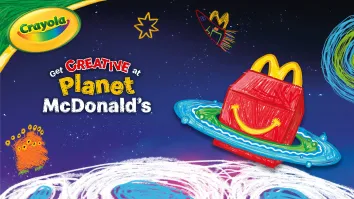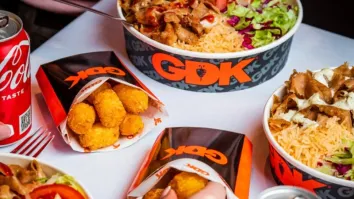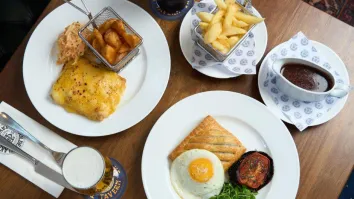
Why QSRs are thriving despite cost crunches
The latest data showed brands have increased their revenues by 39%.
Customers are cutting back as the cost of living continues to bite but quick-service restaurants continue to endure, with some even flourishing and increasing their revenues by 39%, according to data collected by online food ordering technology solutions firm Slerp.
QSR Media talked to JP Then, founder of Slerp, where he shared his thoughts on the changing landscape of the UK’s quick-service restaurant industry, the future of dining in the UK, and how QSRs should adapt and prepare for future challenges.
QSR Media: Are there any interesting developments in the QSR market we should know about?
JP: One broad trend is the next wave of digitalisation. We have seen the first few waves over the past two decades - firstly card payment, then contactless payment via phones and the evolution of POS systems and thirdly, multi-channel operations with delivery via marketplaces.
The fourth wave is a mix of in-house efficiency and becoming truly omnichannel, not just multi-channel.
In-house efficiency is being driven by new technologies that allow businesses to manage their supply chain better (i.e. Rekki, Choco) and also deal with the live operations within a premise (i.e. better KDS systems - i.e. Square, and order aggregation - i.e. Deliverect). These technologies are streamlining back-of-house to ultimately make it more efficient to run operations.
In terms of becoming truly omnichannel, the most innovative businesses are realising that they need diversified revenue streams, to be where the customer is, and allow them to order how they want. This means enabling multiple ordering touchpoints, with heavy investment into their direct digital channels (i.e. allowing people to order directly from their own website or app). The power of direct comes from knowing who the customer is, and then utilising this data to provide a better experience. The hospitality sector is still in the early days of discovering its direct (D2C) channel - it has been led by the global players, but now the mid-market and SME operators are taking notice, and the technology is now there at their fingertips to utilise without significant capital outlay.
QSR Media: What is your current perception of the QSR market here in the UK?
Following on from the above, another trend is the emergence of smaller operators who are driving significant localised demand. Traditionally when you have thought about QSR, it was always dominated by the big brands that are across every high street, so your Greggs and McDonald’s for example. The focus was very much on being quick, convenient and at a price point reflective of the food you were getting.
What we have seen at Slerp is significant popularity in ‘local heroes’ who may have a handful of sites but disproportionate demand for their size. For example, Slerp powers the likes of Dom’s Subs, Willy’s Pies, Poon’s and Pophams Bakery. These exciting businesses have significant social followings which are translating to strong D2C businesses.
I think the surge of popularity we saw with streetfood over the last decade has helped evolve QSR - the public understand that innovative and original food can be made with good quality, fresh ingredients, and still be quick, convenient and affordable.
It is essentially the same as what coffee shops have done here in the UK - we all started off drinking Starbucks and then a lot of great, specialty coffee shops came along. Think Allpress, Hagen (both Slerp Partners) and so on.
Most reports state that customers are cutting back on dining out and deliveries, but your numbers conflict with this. Why do you think your customers aren’t cutting back?
Customers are cutting back - but there are different ways to define what ‘cutting back’ means. Looking at recent collective data, our partners are seeing year-on-year increases of 39% in revenue and a 55% increase in orders per store for both delivery and click-and-collect. It potentially reflects the channel shift of customers wanting to order directly, rather than through a third party or dining out.
Customers are adapting. It might be that they were previously going out with their family, booking a taxi, hiring a babysitter, and so on. Instead, they may be deciding to treat themselves to a takeaway from their favourite place, and they still feel they are having that moment together, but they are saving on the elements they don’t need to spend money on - whilst still getting to enjoy the same food.
Additionally, since the pandemic, we have all seen a real push to support local businesses. Even if a customer doesn’t have deep knowledge of how marketplaces work, there is a general understanding that ordering direct from your favourite restaurant is going to have benefits on both sides.
What do you think customers are looking for now from the industry, following the last few years of turmoil?
It’s clear that customers are tightening their belts due to the inflationary pressures. But customers also still want real value for money and delicious food. This doesn’t necessarily mean defaulting to the cheapest option, but rather purchasing from the businesses they trust and love. And when customers make that decision to spend, they are choosing their moments wisely, and who to spend that money with. This is where local hero QSRs really need to go for it to understand their customer and how they target them. There is a real opportunity out there for them to punch above their weight.
What should QSR brands do in order to generate more revenue despite the cost of living crisis?
Going back to the first point, approaching your business with an omnichannel mindset is key. Diversify your ability to reach customers and invest in D2C to complement third-party marketplaces. Use the rise of D2C as an opportunity to engage with your customer digitally. Gather the intelligence and data, and then work on how to drive repeatability.
Offer exclusive products only available directly - they can be incredibly effective at driving urgency, particularly if they are only available for a limited time. There are so many occasions (special events like the Coronation, new seasonal items, time-limited offers for certain days of the week) that you can build into your marketing calendar to push engaging content. It is a great reason to reach out to your customer base, and they will enjoy hearing from you.
Finally, tie your D2C proposition together with a reward program (i.e. spend £1, get 1 point, get 25 points, get a free side etc.). It drives repeatability and keeps customers coming back for more.
What do you think the future of dining out will look like in the UK?
We actually did some research on this earlier this year which you can read about here.
But one additional trend we think will continue to develop, and that can also drive revenue is dynamic pricing depending on the time of day, week, or year. Customers are used to paying different prices for other products like taxis or hotels depending on when they need them. I think there is a lot that can potentially be done with this idea of flexible pricing. We have seen this done in the sector already in an analogue manner (i.e. happy hour), bringing this to digital is an interesting opportunity for the sector and one that is bound to happen at some point. The technology will soon be available to do this easily and it’s certainly an area Slerp are looking at facilitating.
What is Slerp aiming for in the next five years?
We have been laser-focused on building out a comprehensive ‘motherboard’ to help the hospitality sector embrace D2C ordering. It’s a big task, but we are already in a leading position in the UK and seeing lots of adoption and growth, particularly with delivery. Enabling deep configurability of an operator's setup is where our focus has been. We would like to build out further tools, particularly around helping our partners utilise their customer data easily and effectively. There are a lot of learnings we can take from the retail sector, and we feel hospitality is lagging behind so there is lots of room for improvement. Stay tuned, lots more exciting developments to come!


























